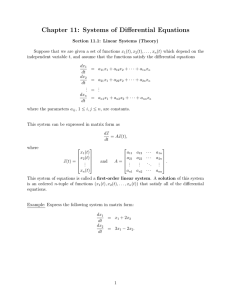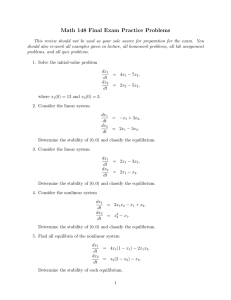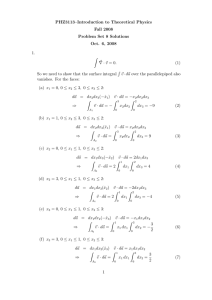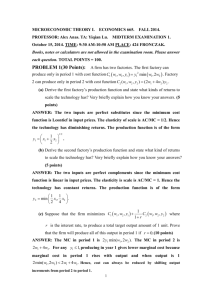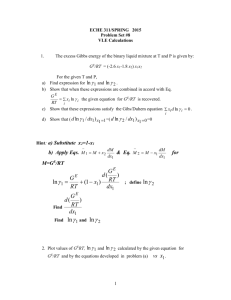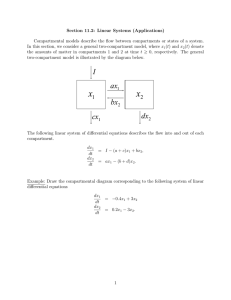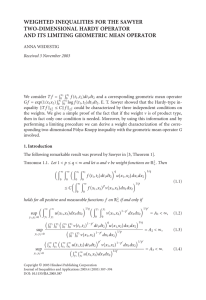Linear Systems of Differential Equations: Theory & Examples
advertisement
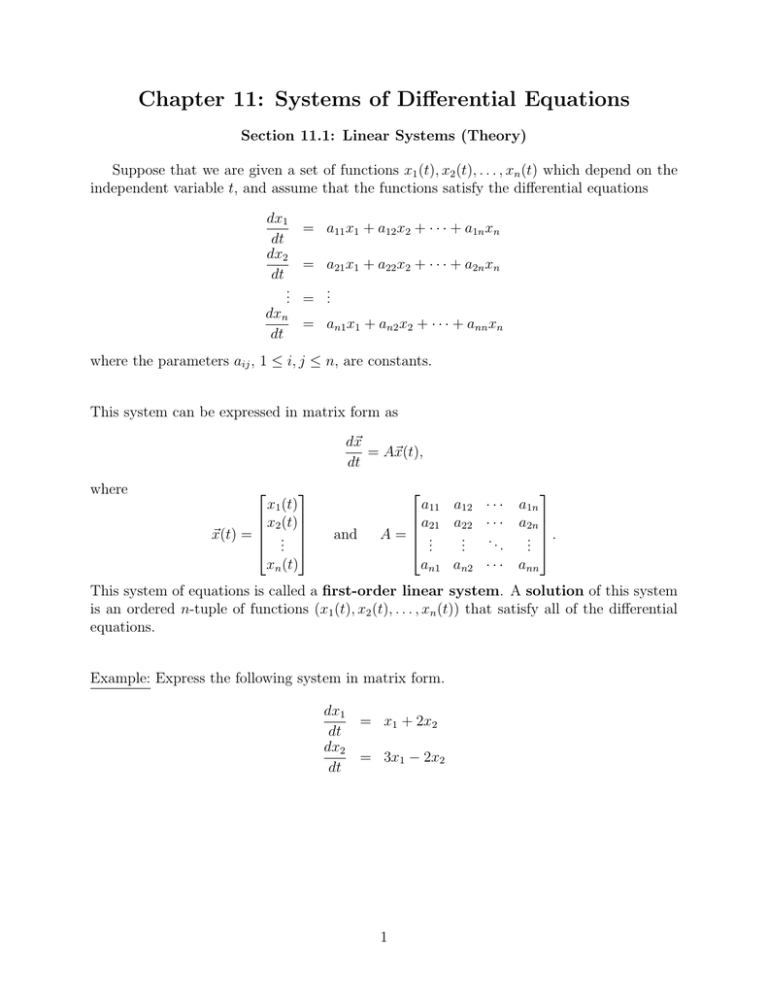
Chapter 11: Systems of Differential Equations Section 11.1: Linear Systems (Theory) Suppose that we are given a set of functions x1 (t), x2 (t), . . . , xn (t) which depend on the independent variable t, and assume that the functions satisfy the differential equations dx1 dt dx2 dt .. . dxn dt = a11 x1 + a12 x2 + · · · + a1n xn = a21 x1 + a22 x2 + · · · + a2n xn . = .. = an1 x1 + an2 x2 + · · · + ann xn where the parameters aij , 1 ≤ i, j ≤ n, are constants. This system can be expressed in matrix form as d~x = A~x(t), dt where x1 (t) x2 (t) ~x(t) = .. . xn (t) and a11 a12 · · · a1n a21 a22 · · · a2n A = .. .. .. . . . . . . . an1 an2 · · · ann This system of equations is called a first-order linear system. A solution of this system is an ordered n-tuple of functions (x1 (t), x2 (t), . . . , xn (t)) that satisfy all of the differential equations. Example: Express the following system in matrix form. dx1 = x1 + 2x2 dt dx2 = 3x1 − 2x2 dt 1 Direction Fields Suppose that ~x(t) = (x1 (t), x2 (t)) represents the position of an object in the x1 x2 -plane at time t ≥ 0, and the functions x1 (t) and x2 (t) satisfy the linear system dx1 = x1 − 2x2 dt dx2 = x2 . dt The linear system determines where the particle will move next. Suppose that the particle is at the point (x1 , x2 ) = (2, −1). At this point, the particle changes position according to the linear system dx1 = 2 − 2(−1) = 4 dt dx2 = −1. dt That is, the particle changes position at (2, −1) by moving in the direction of the vector ~v = h4, −1i. The vector ~v is called a direction vector. Let us sketch a representation of this direction vector in the x1 x2 -plane with initial point at (2, −1). By choosing several points (x1 , x2 ) in the x1 x2 -plane and sketching the corresponding representations of the direction vectors, we obtain a direction field. In the figure below, each direction vector has been normalized. 2 Example: Consider the linear system dx1 = −x2 dt dx2 = x1 + x2 . dt Determine the direction vectors associated with the following points in the x1 x2 -plane, and graph the direction vectors: (1, 0), (0, 1), (−1, 0), (0, −1), (1, 1), (0, 0), and (−2, −2). 3 Example: The normalized direction field for the system dx1 = x1 + 3x2 dt dx2 = 2x1 + 3x2 dt is given below. Sketch the solution trajectories that pass through (1, 0) and (0, 1). Example: The normalized direction field for the system dx1 = x1 + 3x2 dt dx2 = 2x1 + 3x2 dt is given below. Sketch the solution trajectories that pass through (−5, −5) and (3, −5). 4 Solving Linear Systems Theorem: (General Solution of a Homogeneous Linear System) Consider the homogeneous linear system d~x = A~x, dt where A is a 2 × 2 matrix with distinct eigenvalues λ1 and λ2 and corresponding eigenvectors v~1 and v~2 . Then the general solution of the linear system is ~x(t) = c1 eλ1 t v~1 + c2 eλ2 t v~2 where c1 and c2 are constants. Example: Solve the initial-value problem dx1 = x1 + 3x2 dt dx2 = 2x2 dt where x1 (0) = 2 and x2 (0) = −1. 5 Example: Solve the initial-value problem dx1 = 4x1 + 7x2 dt dx2 = x1 − 2x2 dt where x1 (0) = −1 and x2 (0) = −2. 6 Example: Solve the initial-value problem dx1 = −3x1 + 4x2 dt dx2 = −x1 + 2x2 dt where x1 (0) = 1 and x2 (0) = 2. 7 Equilibria and Stability Definition: An equilibrium of a first-order linear system d~x = A~x(t) dt is a solution x̄ = hx¯1 , x¯2 , . . . , x¯n i from which there is no change. That is, dx̄ = Ax̄ = 0. dt An equilibrium is called locally stable if solutions that begin close to that equilibrium approach the equilibrium and unstable if solutions that begin close to that equilibrium move away from it. Note: The solution x̄ = ~0 is an equilibrium of any homogeneous linear system. Thus, it is called the trivial equilibrium. If det A 6= 0, then ~0 is the only equilibrium, and if det A = 0, then there will be other equilibria. Theorem: (Stability of Homogeneous Linear Systems) Consider the homogeneous linear system d~x = A~x(t), dt where A is a 2 × 2 matrix with eigenvalues λ1 and λ2 . Case 1: Distinct Real Eigenvalues (λ1 6= λ2 ) 1. If both eigenvalues are negative, then ~0 = (0, 0) is called a sink or stable node. 2. If both eigenvalues are positive, then ~0 = (0, 0) is called a source or unstable node. 3. If the eigenvalues have opposite signs, then ~0 = (0, 0) is called a saddle point. Case 2: Complex Conjugate Eigenvalues (λ = a ± bi) 1. If both eigenvalues have negative real parts, then ~0 is called a stable spiral. 2. If both eigenvalues have positive real parts, then ~0 is called an unstable spiral. 3. If both eigenvalues are purely imaginary, then ~0 is called a neutral spiral or center. 8 Phase Portraits The phase portraits below illustrate the various cases for stability of (0, 0). The solution trajectories are plotted in blue and the lines defined by the eigenvectors are plotted in red. 9 Example: Consider the homogeneous linear system dx1 = −2x1 + 4x2 dt dx2 = 2x1 − 5x2 . dt Determine the stability of (0, 0) and classify the equilibrium. Example: Consider the homogeneous linear system dx1 = 6x1 − 4x2 dt dx2 = −3x1 + 5x2 . dt Determine the stability of (0, 0) and classify the equilibrium. 10 Example: Consider the homogeneous linear system dx1 = −5x1 − 2x2 dt dx2 = 6x1 + 3x2 . dt Determine the stability of (0, 0) and classify the equilibrium. Example: Consider the homogeneous linear system dx1 = −x1 − 5x2 dt dx2 = 4x1 − 3x2 . dt Determine the stability of (0, 0) and classify the equilibrium. 11 Example: Consider the homogeneous linear system dx1 = x1 + 3x2 dt dx2 = −2x1 + x2 . dt Determine the stability of (0, 0) and classify the equilibrium. Example: Consider the homogeneous linear system dx1 = −2x2 dt dx2 = 2x1 . dt Determine the stability of (0, 0) and classify the equilibrium. 12
